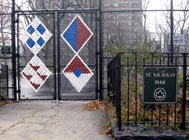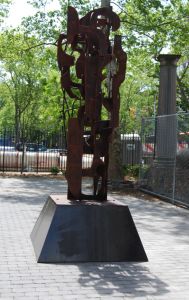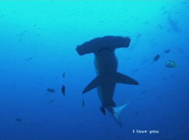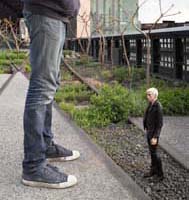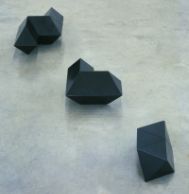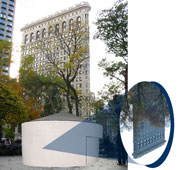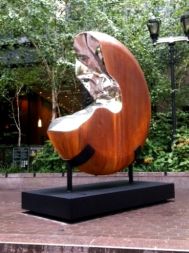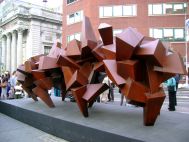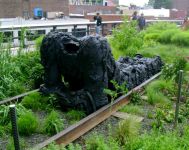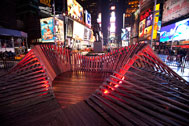Art in the Parks
Through collaborations with a diverse group of arts organizations and artists, Parks brings to the public both experimental and traditional art in many park locations. Please browse our list of current exhibits and our archives of past exhibits below. You can also see past grant opportunities or read more about the Art in the Parks Program.
Public Art Map and Guide
Find out which current exhibits are on display near you, and browse our permanent monument collection.
Search Current and Past Exhibits
2013
Manhattan
Katherine Daniels, St. Nicholas Park Mesh
December 13, 2012 to April 22, 2013
St. Nicholas Park, Manhattan
Map/Directions (in Google Maps)
Please note: This is a past exhibit that is no longer installed in the park.
Katherine Daniels highlights the park’s eclectic, though largely overlooked, history through a series three contemporary weavings on the park’s basketball court fences. On the southern end of the park, the chain link fence hosts an abstract vine design based on Native American textiles and recounts the Indian path Weekquaeskeek, which passed along what is now St. Nicholas Avenue. The central installation of crosiers, or hooked shepherd staffs, references the park’s namesake and the three churches that border the park. Located near the Hamilton Grange, home of founding father Alexander Hamilton, the northernmost court is adorned with a zig-zag pattern of “quilt squares.” This monumental brocade represents the park’s early American history as a military campground during the Battle of Harlem Heights, where General George Washington positioned himself during the Revolutionary War in 1776.
![]()
Robert Sestok, First Street Iron
April 20, 2012 to April 20, 2013
First Park, Manhattan
Map/Directions (in Google Maps)
Please note: This is a past exhibit that is no longer installed in the park.
Robert Sestok spent most of his career living and working in downtown Detroit, Michigan, which greatly influenced his artistic methods. As part of Detroit’s Cass Corridor arts community, a vibrant movement of artists, musicians, poets and writers during the 60s and 70s, Sestok frequently used found objects and other non-traditional materials, tearing things apart and reconstructing them. This deconstructivist process reflected the reality of the city at the time, and can still be seen today. Though hailing from the Motor City, Sestok frequented New York throughout his life and stated that First Street Iron is “a tribute to my past associations with the city of New York.”
This ten-foot-tall, welded steel sculpture will be placed in the formerly inaccessible property at 33 First Street acquired by New York City’s Parks & Recreation the in 1935. Since 2008, First Street Green (FSG) has worked with Parks Department to revitalize the fallow lot adjacent to First Park—with the goal to remove the rubble and create a plaza and cultural space. The lot was fully renovated with a newly stabilized and paved plaza, landscaping and cast-iron fencing in 2011 when the park hosted the BMW Guggenheim Lab, a three-month temporary pavilion and public forum in which a varied range of cultural activities occurred. During this period 55,000 visitors attended—reinforcing First Street Green’s original observation of a strong need and broad interest in an ongoing cultural space open for public use.
This exhibition is presented by First Street Green.
![]()
Uri Aran, Untitled (Good & Bad)
April 19, 2012 to April 14, 2013
Between West 25th and West 26th Streets
The High Line, Manhattan
Map/Directions (in Google Maps)
Please note: This is a past exhibit that is no longer installed in the park.
For the High Line, Uri Aran presents a sound work that explores how we use personification and animal metaphors to define human behavior in our daily conversations. Working with a professional voice actor who uses a formal, slightly affected pronunciation, Aran has created a sound track that will emanate softly from the planting beds below the elevated pathway on the High Line between West 25th and West 26th Streets. The sound track features the actor reading a list of creatures, from common ones, like the household cat and the spider, to more wild ones, such the platypus and the shark, each described as “good” or “bad.” Serious and at times comical, the expressionless tone of the actor’s voice will clash with the definition of these creatures as either “good” or “bad,” sparking dialogue about the arbitrary nature of classification in language.
“Uri Aran’s imaginative works have always amazed me,” said Cecilia Alemani, the Donald R. Mullen, Jr. Curator and Director of High Line Art. “I look forward to watching visitors experience this installation and how they react to it as they walk along the High Line.”
This exhibition is presented by the Friends of the High Line.
![]()
Various, Lilliput
April 19, 2012 to April 14, 2013
Throughout the High Line
The High Line, Manhattan
Please note: This is a past exhibit that is no longer installed in the park.
Lilliput will reflect on the traditional role of public art by offering a counterbalance to the monumental scale often employed for plaza sculptures and other outdoor installations in public spaces. As the first project in the HIGH LINE COMMISSIONS series for spring, 2012, Lilliput will feature miniature sculptures installed in unusual and unexpected places at the High Line – amongst the vegetation and along the pathway – to create an art treasure hunt for visitors. Lilliput takes its title from Jonathan Swift’s Gulliver’s Travels, conjuring a magical world populated by fairy tale creatures, mysterious idols, and dreamlike landscapes.
Lilliput will feature installations by six artists from around the globe:
Oliver Laric, Alessandro Pessoli, Tomoaki Suzuki, Francis Upritchard, Erika Verzutti, llyson Vieira
This exhibition is presented by the Friends of the High Line.
![]()
Tony Smith, One-Two-Three
March 13, 2013 to April 10, 2013
Bryant Park, Manhattan
Map/Directions (in Google Maps)
Please note: This is a past exhibit that is no longer installed in the park.
This installation of One-Two-Three, created in 1976, is part of a series of exhibitions commemorating the artist’s centennial. Consisting of three geometrical modular painted steel black units weighing a total of 2,700 pounds, One-Two-Three asserts a presence that requires viewers to respond to the work in physical terms as well as visual. Smith found his sculptures most appreciated and “accepted” in an environment involving nature, as opposed to the confining walls of an institution or gallery.
This is Tony
Smith’s second public art installation in Bryant Park. His 1967
installation in Bryant Park inaugurated the public arts programming in
New York City parks. Tony Smith (1912-1980) was born in South Orange,
New Jersey. A leading figure of American Minimalism, his work has been
the subject of major solo exhibitions at prestigious museums including a
retrospective at the Museum of Modern Art, New York in 1998.
This exhibition is presented by the Art Production Fund and the Bryant Park Corporation.
![]()
Sandra Gibson and Luis Recorder, Topsy-Turvy: A Camera Obscura Installation
March 1, 2013 to April 5, 2013
Madison Square Park, Manhattan
Map/Directions (in Google Maps)
Please note: This is a past exhibit that is no longer installed in the park.
Topsy-Turvy reimagines one of the world’s oldest moving image devices into a life-sized 10-foot by 10-foot structure. Park visitors are able to enter the interactive, large-scale installation, which utilizes the physical properties of light to capture images of the surrounding Flatiron District in real time. This centuries-old artistic medium alters how visitors experience the park and engages with the various elements of New York City’s urban landscape through a new and exciting lens.
This exhibition is presented by Madison Square Park Conservancy.
![]()
Jonathan Prince, G2V
October 2012 to April 2013
Staircase
Dag Hammarskjold Plaza, Manhattan
Map/Directions (in Google Maps)
Please note: This is a past exhibit that is no longer installed in the park.
Interested in evoking archeological artifacts, Jonathan Prince creates sleek sculptural forms with broken edges with his Fragments series. His partial articulation of form allows the audience to participate in the piece, rather than passively view his sculptural work. His 2012 piece, G2V, incorporates exaggerated “broken” edges, creating a dynamic tension with the highly refined form of this stainless steel sculpture.
This exhibition is presented by Cynthia Reeves Projects.
![]()
Malcolm D. MacDougall, Microscopic Landscape
June 14, 2012 to March 31, 2013
Union Square Park, Manhattan
Map/Directions (in Google Maps)
Please note: This is a past exhibit that is no longer installed in the park.
Sharing a natural dialogue with Union Square at the vibrant nexus of New York City is Malcolm D. MacDougall’s sculpture, Microscopic Landscape. The 24 foot, 7,500 lb work “is about potential energy and pushing a stagnant object as close to perceived movement as possible.” The constant motion found in Union Square is a microcosm teeming with diversity that defines the city, finding its inspiration in the multifaceted structures of the sculpture, and in turn inspiring this artist to observe activities as seen on the molecular level. The sculpture serves as a snapshot of the ongoing activity in the neighborhood; it is a static object that maintains the constant anticipation of movement, just as the grounds of Union Square provide the framework for the energetic flow of people and commerce. This exhibition is presented in conjunction with the Union Square Partnership.
![]()
Thomas Houseago, Lying Figure
May 18, 2012 to March 14, 2013
At Little West 12th Street
The High Line, Manhattan
Map/Directions (in Google Maps)
Please note: This is a past exhibit that is no longer installed in the park.
Known for using materials like wood, clay, plaster, steel, and bronze, Houseago creates monumental sculptures that reveal the process of their making through unique details – the varying texture of a molding, the hidden creases within a cast – despite their imposing size and towering forms. His sculptures also incorporate drawing in the form of sketches on plaster and wood panels. Houseago’s work explores abstract lines and figurative forms, and in doing so he joins a long tradition of sculptors that spans from Giacometti to Picasso, engaging viewers with qualities that are at once impressive and enchanting.
For the High Line, Houseago presents Lying Figure, a 15-foot-long bronze sculpture of a headless giant resting on its elbows on the wooden rail ties between the High Line’s original rail tracks. As the third project in the HIGH LINE COMMISSIONS series for spring, 2012, Houseago’s Lying Figure will juxtapose Lilliput, the group exhibition that debuted on Thursday, April 19. Lilliput takes its title from Jonathan Swift’s Gulliver’s Travels, and conjures a magical world populated by fairy tale creatures, mysterious idols, and dreamlike landscapes. Houseago’s Lying Figure will introduce the presence of a giant – the park’s own Gulliver – into Lilliput’s diminutive sculptures installed along the park’s pathway and amidst the plants.
This exhibition is presented by the Friends of the High Line
![]()
Situ Studio, Heartwalk
February 12, 2013 to March 10, 2013
between 46th-47th Streets and Broadway & 7th Avenue
Father Duffy Square, Manhattan
Map/Directions (in Google Maps)
Please note: This is a past exhibit that is no longer installed in the park.
Brooklyn-based design firm Situ Studio is the winner of this year's annual Times Square Valentine Heart Design. Over the last five years, the Times Square Alliance has invited architecture and design firms to submit proposals for a romantic public art installation celebrating Valentine's Day in Times Square.
Situ Studio took inspiration from the collective experience of Hurricane Sandy and the love that binds people together during trying times. Using boardwalk boards salvaged during Sandy's aftermath from Long Beach, New York; Sea Girt, New Jersey; and Atlantic City, New Jersey. Heartwalk begins as two ribbons of wooden planks that fluidly lift from the ground to form a heart shaped enclosure in the middle of Duffy Square. The slatted construction, illuminated from within, provides varied views of the interior as visitors move around the perimeter of the installation.
Visitors can enter the installation itself and literally stand in the heart of the world's greatest city
Presented by the Times Square Alliance in partnership with the Design Trust For Public Space. For more information visit www.timessquarenyc.org/heartwalk
![]()
